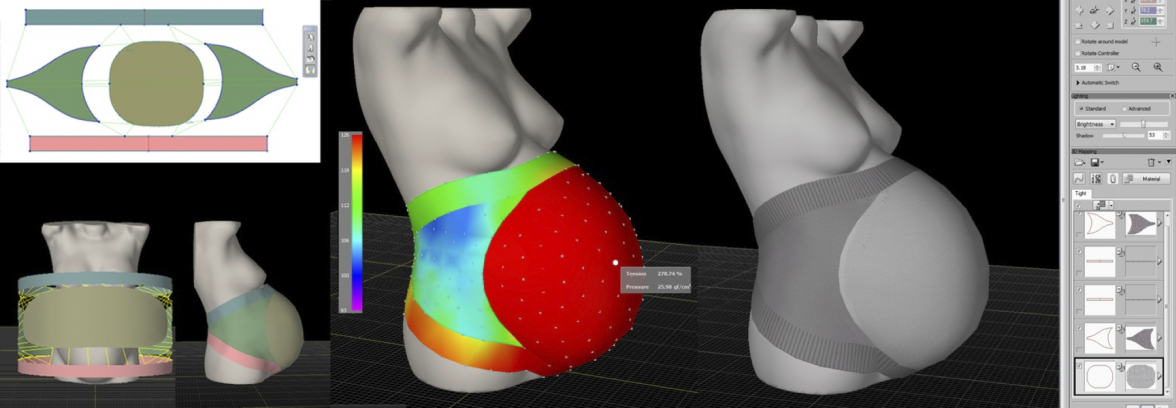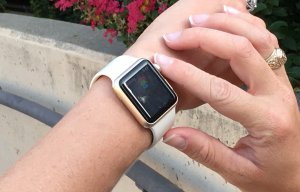Hexcel presents composite materials at SAMPE China 2017
Research/Development/Education
Smart ’belly band’ could monitor high risk pregnancies
Researchers at Drexel University are combining fashion design with wireless technology to produce a belly band that will be able to monitor uterine contractions and foetal heart rate in real time. Will it catch on?

20th May 2014
Innovation in Textiles
|
Philadelphia
Tummy hugging maternity wear could soon be giving expecting parents peace of mind in addition to stylishly securing waistlines, according to researchers at Drexel University in Philadelphia, USA. The researchers are combining fashion design with wireless technology to produce a belly band that will be able to monitor uterine contractions and foetal heart rate in real time. The band will be undergoing clinical trials this summer.
The band, which is in prototype production at the Shima Seiki Haute Technology Laboratory in Drexel’s Expressive & Creative Interaction Technologies (ExCITe) Center, could be used to monitor high-risk pregnancies, women near their due dates or as a quick, non-invasive procedure during a routine check-up, according to Owen Montgomery, M.D., head of obstetrics and gynecology at Drexel’s College of Medicine, one of the researchers working on the project.
“Current foetal and uterine monitoring requires patients to come into the hospital or testing centre to be hooked up to a machine,” Montgomery said. “For high-risk pregnancy situations these visits can be quite frequent and inconvenient. The technology is also limited in what it can monitor and in some situations, rather invasive.”
Montgomery and Genevieve Dion, a fashion design professor in the Antoinette Westphal College of Media Arts & Design and director of the Shima Seiki Haute Technology Laboratory, are working with Kapil Dandekar, PhD, Adam Fontecchio, PhD, and Timothy Kurzweg, PhD, researchers in the College of Engineering, to produce the smart garment. The collaboration is supported by the Coulter-Drexel Partnership for Innovation in the School of Biomedical Engineering, Science & Health Systems.
 Following the signing of a groundbreaking, $1 million agreement with Shima Seiki USA in February 2012, Dion has a state-of-the-art laboratory to conduct research for the development of new smart textiles and wearable technologies, and to explore new methods of production that will ultimately impact a number of market sectors. ( See Drexels $1m Shima Seiki smart textiles laboratory on our Knitting Industry site).
Following the signing of a groundbreaking, $1 million agreement with Shima Seiki USA in February 2012, Dion has a state-of-the-art laboratory to conduct research for the development of new smart textiles and wearable technologies, and to explore new methods of production that will ultimately impact a number of market sectors. ( See Drexels $1m Shima Seiki smart textiles laboratory on our Knitting Industry site).
Dion, who was recently named one of Fast Company magazine’s “100 Most Creative People in Business,” uses Shima Seiki’s software and computerized flat knitting machines to incorporate new types of yarns into the garments she produces. With a three-dimensional digital rendering of the band, Dion can accurately design it to fit snugly over the midsection of the expecting mother before it is programmed to be knitted.
“The Shima Seiki Haute Technology Laboratory is dedicated to advancing the field of wearable technology, laying the foundation for modular and flexible production intended for a variety of high-performance textile applications,” Dion said.
“Knitting fabrication holds remarkable potential for innovative and customizable design solutions in an array of applications. Multidisciplinary research, with strong support from industry partnerships, enables us to produce future fabrics and materials that empower designers to create products that can be ‘smart,’ functional and beautiful.”
Using electrically conductive yarns, the Shima Seiki machines are programmed to seamlessly knit a pattern across the centre of the band that serves as a wireless, passive radio frequency identification (RFID) tag. From there, signal processing algorithms developed in Drexel’s Electrical and Computer Engineering laboratories by Dandekar, Fontecchio and Kurzweg, processes the changes in received signal characteristics from the RFID to measure the intensity of the uterine contractions and other medical information from mother and foetus.
“Because this is wireless technology, doctors will be able to monitor their patients inside or outside of a hospital and perhaps eventually it will be developed into a monitoring service that could immediately signal medical professionals if there is a problem,” Dandekar said.
Montgomery will be putting the team’s prototype of the belly band through clinical trials over the summer. The band’s first application is likely to be for monitoring uterine contractions and, if successful, continued work could allow it to be used for additional foetal monitoring.

Business intelligence for the fibre, textiles and apparel industries: technologies, innovations, markets, investments, trade policy, sourcing, strategy...
Find out more









